Physical Model Test and Heat Transfer Analysis on Backfilling Construction of Qinghai-Tibet Transmission Line Tower Foundation
Abstract
:1. Introduction
2. Experimental Scheme and Method
2.1. Foundation Model
2.2. Experimental Materials
2.3. Temperature Sensors Layout
2.4. Experimental Boundary Conditions
3. Results and Analysis
3.1. Initial Temperature
3.2. Temperature Variation along with the Depth
3.3. Boundary Conditions of Foundation and Backfill
3.4. Thermal Effect of the Foundation
3.5. Refreezing Process of Foundation Backfill
4. Discussion
5. Conclusions
Author Contributions
Funding
Institutional Review Board Statement
Informed Consent Statement
Data Availability Statement
Conflicts of Interest
References
- Qi, J.L.; Ma, W. State-of-art of research on mechanical properties of frozen soils. Rock Soil Mech. 2010, 31, 133–143. [Google Scholar]
- Wu, Y.P.; Guo, C.X.; Pan, W.D.; Zhao, S.Y.; Zhang, L.X. Influences of refreezing process of ground on bearing capacity of single pile and bridge construction in permafrost. Chin. J. Rock Mech. Eng. 2004, 23, 4229–4233. [Google Scholar]
- Wang, X.; Jiang, D.J.; Zhao, X.Y.; Liu, D.R. Experimental study on bearing features of bored pile under non-refreezing condition in permafrost region. Chin. J. Rock Mech. Eng. 2005, 27, 81–84. [Google Scholar]
- Shang, Y.H.; Niu, F.J.; Wu, X.Y.; Liu, M.H. A novel refrigerant system to reduce refreezing time of cast-in-place pile foundation in permafrost regions. Appl. Therm. Eng. 2018, 128, 1151–1158. [Google Scholar] [CrossRef]
- Yu, Q.H.; Wen, Z.; Ding, Y.S.; Wang, G.S.; Li, G.Y.; Zhang, J.M. Monitoring the Tower Foundations in the Permafrost Regions along the Qinghai-Tibet DC Transmission Line from Qinghai Province to Tibetan Autonomous Region. J. Glaciol. Geocryol. 2012, 34, 1165–1172. [Google Scholar]
- Ran, Y.H.; Li, X.; Cheng, G.D.; Nan, Z.T.; Che, J.X.; Sheng, Y.; Wu, Q.B.; Jin, H.J.; Luo, D.L.; Tang, Z.G.; et al. Mapping the permafrost stability on the Tibetan Plateau for 2005–2015. Sci. China-Earth Sci. 2021, 1, 62–79. [Google Scholar] [CrossRef]
- Verma, A.K.; Joshi, R.K. Uplift load carrying capacity of piles in sand. In Proceedings of the Indian Geotechnical Conference, Mumbai, India, 16–18 December 2010. [Google Scholar]
- Liu, G.; Zhang, Z.; Cui, Q. Uplift Behavior of Belled Piles Subjected to Static Loading. Arab. J. Sci. Eng. 2021, 46, 4369–4385. [Google Scholar] [CrossRef]
- Lutenegger, A.J. Uplift tests on shallow cast-in-place enlarged base pedestal foundations in clay. In Proceedings of the American Society of Civil Engineers IFCEE 2015—San Antonio, San Antonio, TX, USA, 17–21 March 2015. [Google Scholar]
- Honda, T.; Hirai, Y.; Sato, E. Uplift capacity of belled and multibelled piles in dense sand. Soils Found. 2011, 51, 483–496. [Google Scholar] [CrossRef] [Green Version]
- Ilamparuthi, K.; Dickin, E. The influence of soil reinforcement on the uplift behaviour of belled piles embedded in sand. Geotext. Geomembr. 2001, 19, 1–22. [Google Scholar] [CrossRef]
- Guo, L. Study on the Displacement Characteristics of Tower Foundations in Permafrost Regions and the Improvement. Ph.D. Thesis, Cold and Arid Regions Environmental and Engineering Research Institute, Chinese Academy of Sciences, Beijing, China, 2016. [Google Scholar]
- Zhang, J.M.; Ruan, G.F.; Su, K. Estimation on settlement of precast tower footings along the Qinghai–Tibet Power Transmission Line in warm permafrost regions. Cold Reg. Sci. Technol. 2016, 121, 275–281. [Google Scholar] [CrossRef]
- Wang, T.; Zhou, G.Q.; Wang, J.Z. Stochastic Thermal-Mechanical Characteristics of Frozen Soil Foundation for a Transmission Line Tower in Permafrost Regions. Int. J. Geomech. 2018, 18, 88–91. [Google Scholar] [CrossRef]
- Shi, X.Y.; Zhang, Z.; Li, D.Q.; Zhang, Z.Q. Model Test Study on Refreezing Process of Backfill in Cone-cylindrical Pile Foundation Pit. J. Hunan Univ. (Nat. Sci.) 2018, 45, 125–134. [Google Scholar]
- Shi, X.Y.; Zhang, Z.; Li, D.Q.; Zhou, P.F.; Feng, W.J. Research on dynamic variation of moisture, temperature and deformation of cone-cylindrical pile under freeze–thaw cycles. Chin. J. Geotech. Eng. 2019, 38, 3092–3101. [Google Scholar]
- You, Y.H.; Yu, Q.H.; Guo, L.; Wang, X.B.; Hu, J.; Qian, J.; Zhang, H. In-situ monitoring the thermal regime of foundation backfill of a power transmission line tower in permafrost regions on the Qinghai-Tibet Plateau. Appl. Therm. Eng. 2016, 98, 271–279. [Google Scholar] [CrossRef]
- Xie, Y.L.; Yu, Q.H.; You, Y.H.; Zhang, Z.Q.; Gou, T.T. The changing process and trend of ground temperature around tower foundations of Qinghai-Tibet Power Transmission line. Sci. Cold Arid. Reg. 2019, 11, 13–20. [Google Scholar]
- Li, G.Y.; Yu, Q.H.; Ma, W.; Chen, Z.Y.; Mu, Y.H.; Guo, L.; Wang, F. Freeze–thaw properties and long-term thermal stability of the unprotected tower foundation soils in permafrost regions along the Qinghai-Tibet Power Transmission Line. Cold Reg. Sci. Technol. 2016, 121, 226–236. [Google Scholar] [CrossRef]
- Mu, Y.H.; Li, G.Y.; Yu, Q.H.; Ma, W.; Wang, D.Y.; Wang, F. Numerical study of long-term cooling effects of thermosyphons around tower footings in permafrost regions along the Qinghai-Tibet Power Transmission Line. Cold Reg. Sci. Technol. 2016, 121, 237–246. [Google Scholar] [CrossRef]
- Yu, Q.H.; Zhang, Z.Q.; Wang, G.S.; Guo, L.; Wang, X.B.; Wang, P.F.; Bao, Z.H. Analysis of tower foundation stability along the Qinghai–Tibet Power Transmission Line and impact of the route on the permafrost. Cold Reg. Sci. Technol. 2016, 121, 205–213. [Google Scholar] [CrossRef]
- Guo, L.; Yu, Q.H.; You, Y.H.; Wang, X.B.; Yuan, C.; Li, X.N. Evaluation on the influences of lakes on the thermal regimes of nearby tower foundations along the Qinghai-Tibet Power Transmission Line. Appl. Therm. Eng. 2016, 102, 829–840. [Google Scholar] [CrossRef]
- Guo, L.; You, Y.; Yu, Q.; Shi, Z.; Li, H.; Wang, X. Field investigation on the influence of periglacial processes on pile foundations on the Qinghai–Tibet plateau. Permafr. Periglac. Process. 2021, 32, 335–348. [Google Scholar] [CrossRef]
- Khosravani, M.R.; Weinberg, K. Experimental investigations of the environmental effects on stability and integrity of composite sandwich T-joints [Experimentelle Untersuchung des Umwelteinflusses auf die Belastbarkeit von T-Stößen in Sandwich-Platten]. Mater. Werkst. 2017, 48, 753–759. [Google Scholar] [CrossRef]
- Zhang, W.; Liu, Y.Z.; Wu, M.Q. Theory and experiment of nonlinear vibrations and dynamic snap-through phenomena for bi-stable asymmetric laminated composite square panels under foundation excitation. Compos. Struct. 2019, 225, 111140. [Google Scholar] [CrossRef]
- Yu, Q.; Ji, Y.; Zhang, Z.; Wen, Z.; Feng, C. Design and research of high voltage transmission lines on the Qinghai–Tibet Plateau—A Special Issue on the Permafrost Power Lines. Cold Reg. Sci. Technol. 2016, 121, 179–186. [Google Scholar] [CrossRef]
- Guo, L.; Zhang, Z.Q.; Wang, X.B.; Yu, Q.H.; You, Y.H.; Yuan, C.; Gou, T.T. Stability analysis of transmission tower foundations in permafrost equipped with thermosiphons and vegetation cover on the Qinghai-Tibet Plateau. Int. J. Heat Mass Transf. 2018, 121, 367–376. [Google Scholar] [CrossRef]
- Zhu, L.N.; Li, D.Q.; Guo, X.M. Simulitude Analysis of Modeling Test for Chargeless Pressure in the Freezing-thawing Process of soil. J. Glaciol. Geocryol. 1993, 15, 166–169. [Google Scholar]
- Zhu, L.N. Study of the adherent layer on different types of ground in permafrost 10 regions on the Qinghai–Xizang Plateau. J. Glaciol. Geocryol. 1988, 10, 8–14. [Google Scholar]
- Xu, X.Z.; Wang, J.C.; Zhang, L.X. Physics of Frozen Soil; Science Press: Beijing, China, 2010. [Google Scholar]
- Wang, G.H.; Yu, Q.H.; Guo, L.; You, Y.H.; Wang, S.J.; Yu, Y. Prevention and control of freezing and thawing disasters electric transmission lines constructed in permafrost regions. J. Glaciol. Geocryol. 2014, 36, 137–143. [Google Scholar]

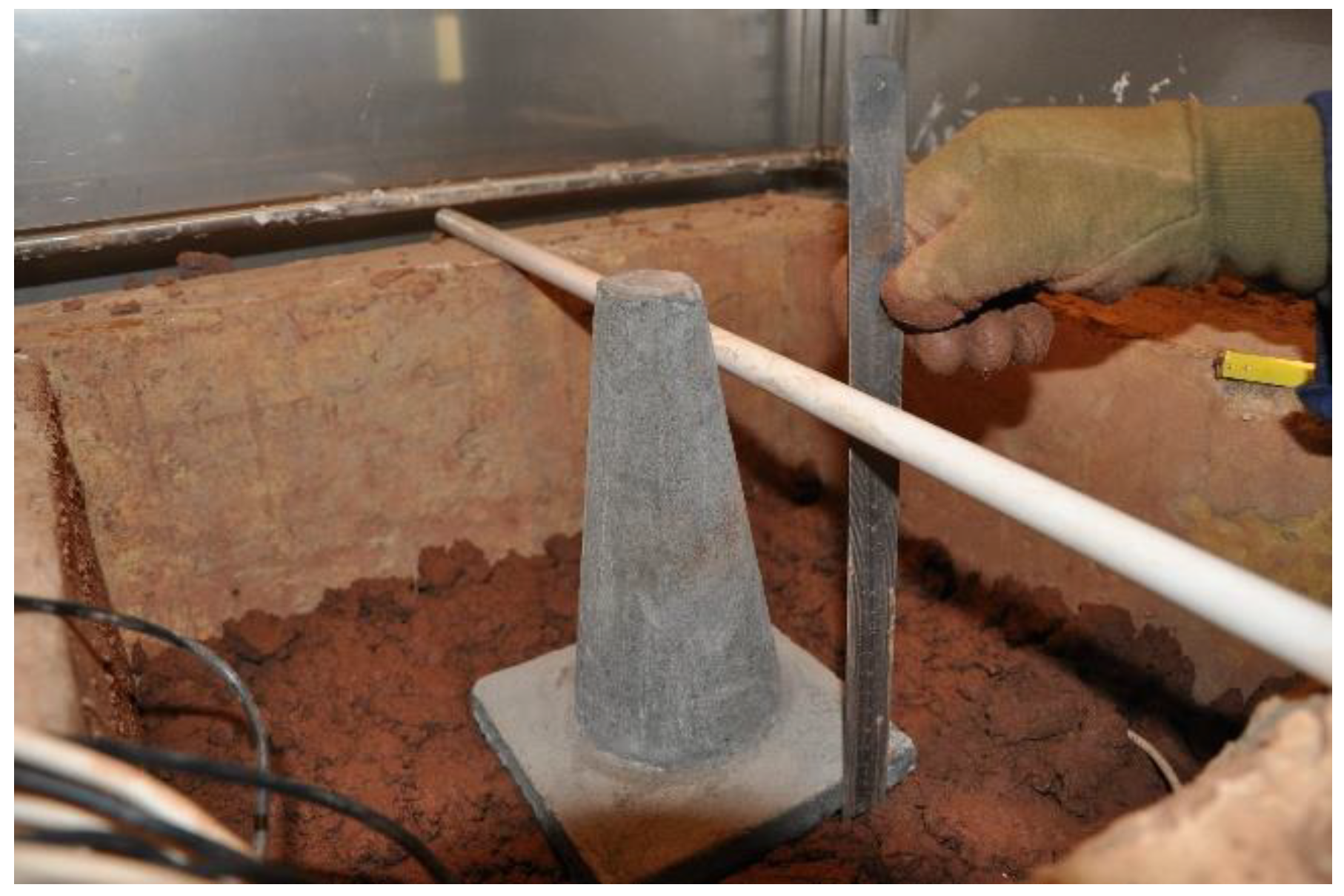
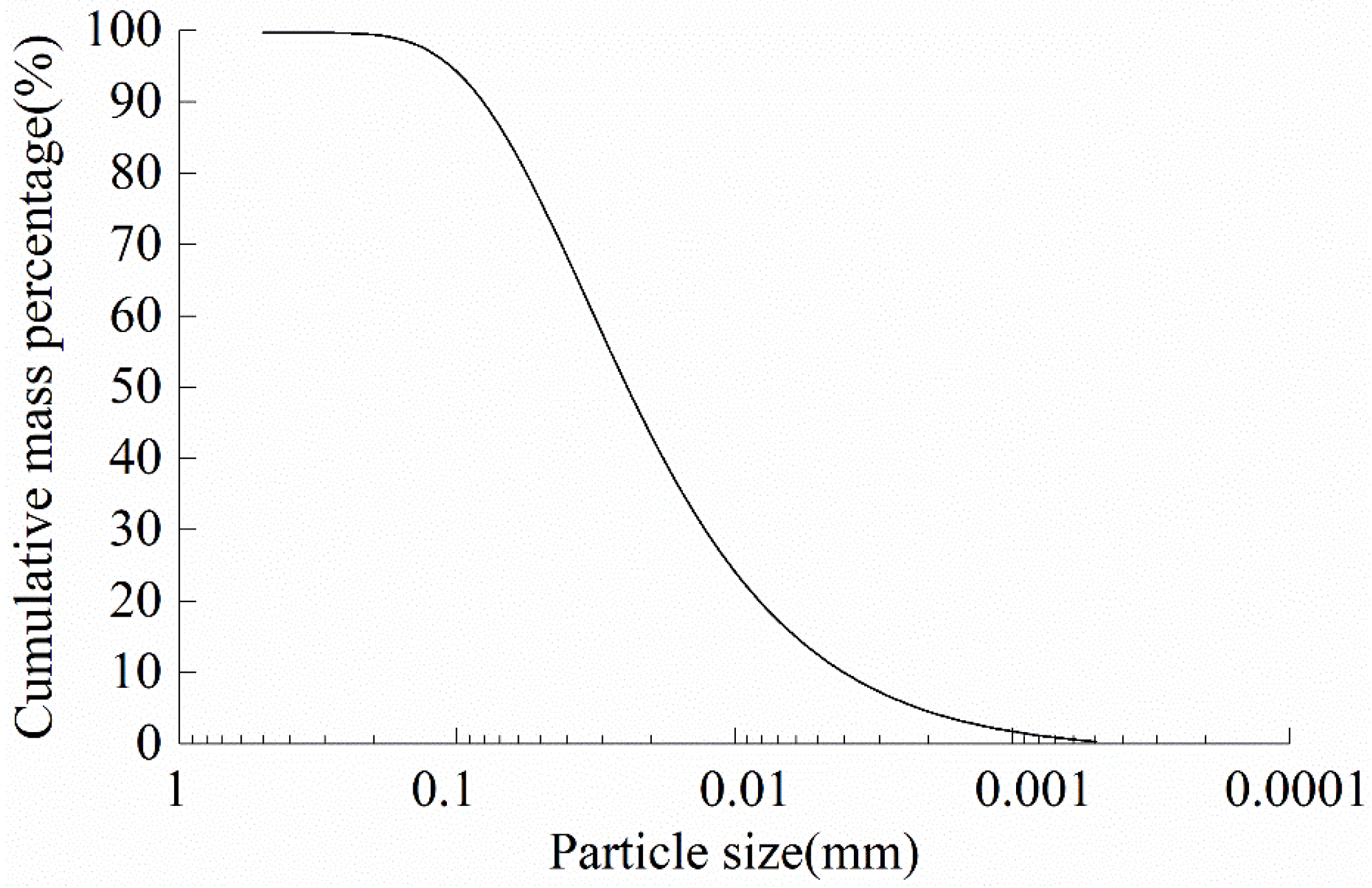


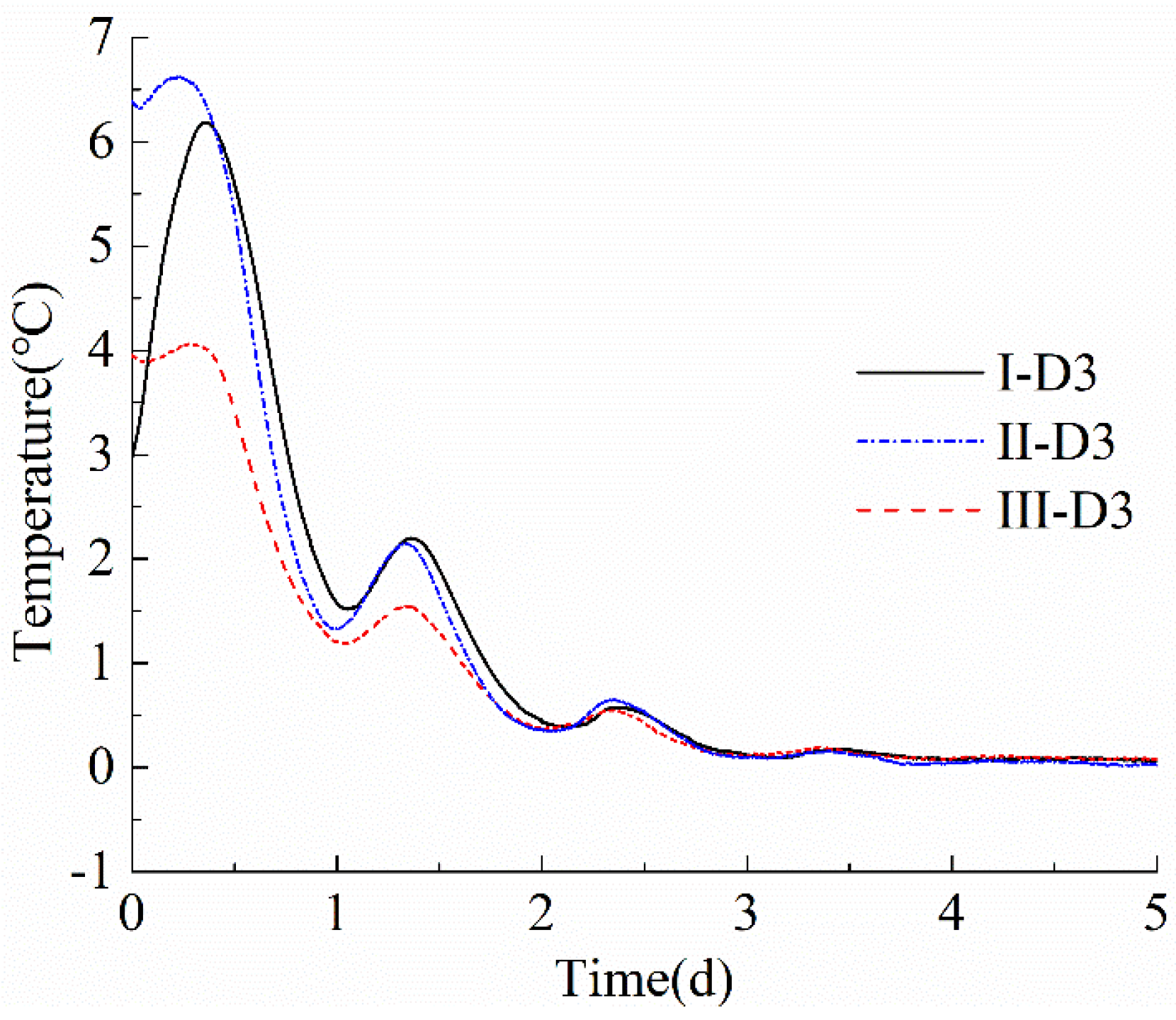

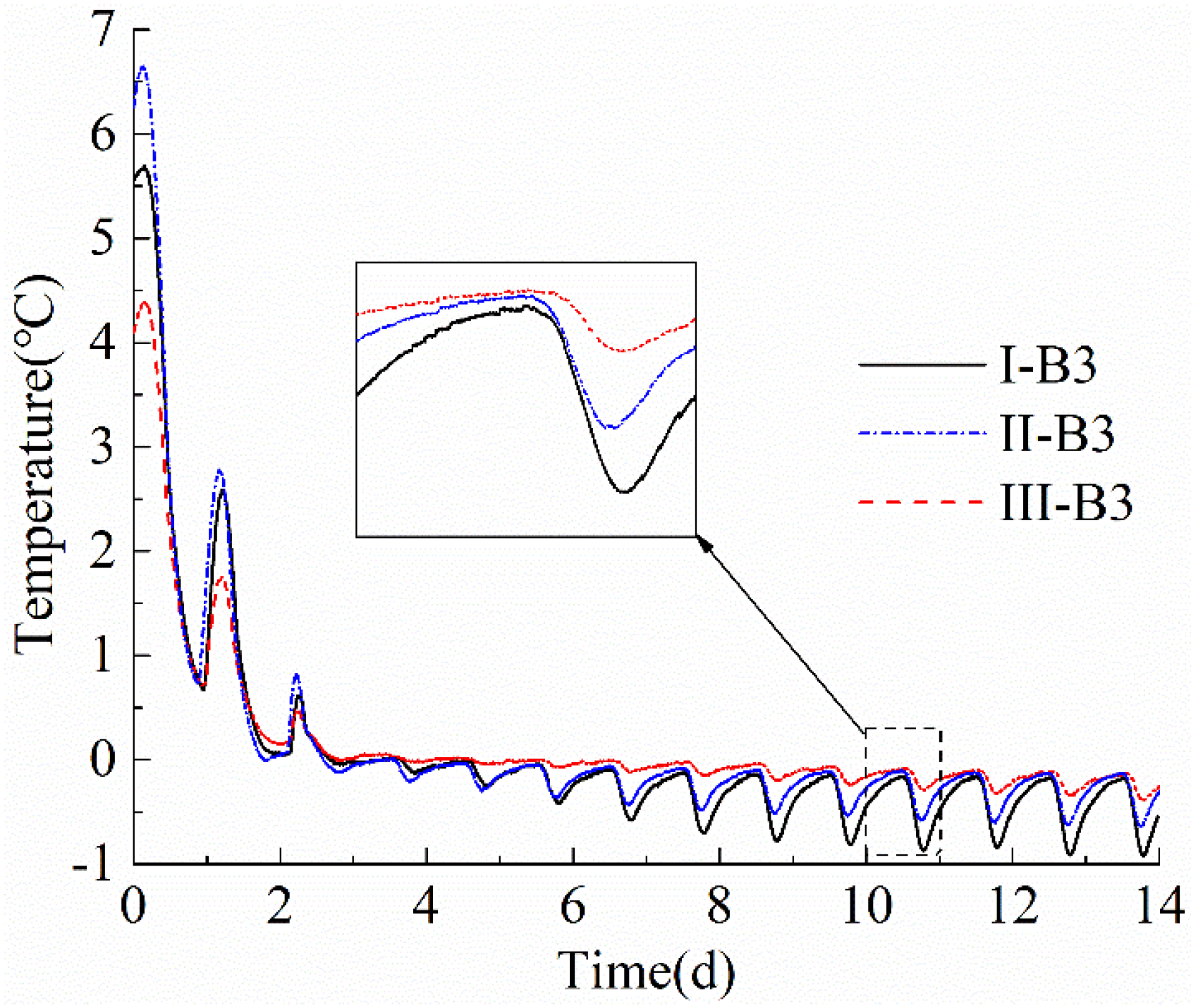




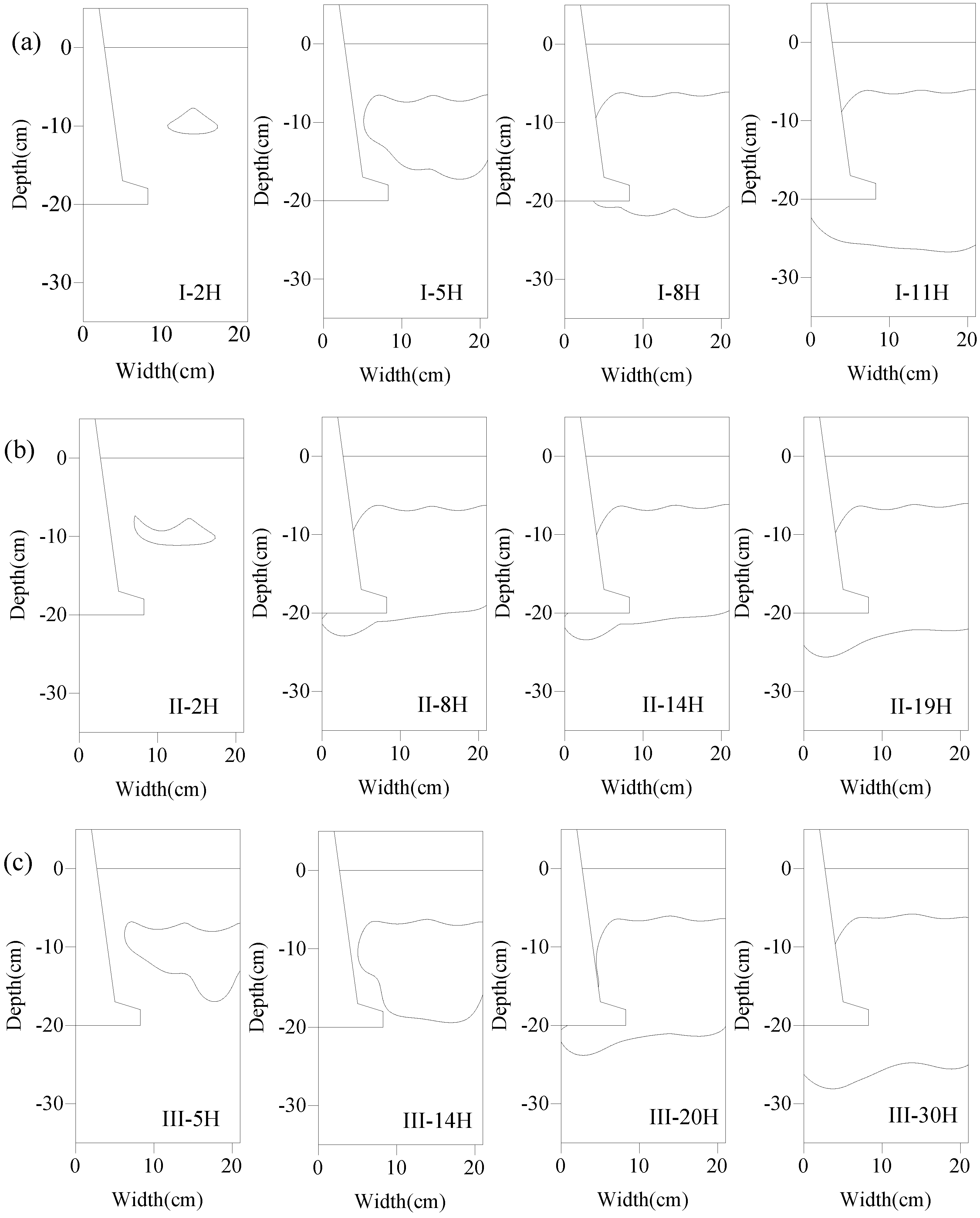
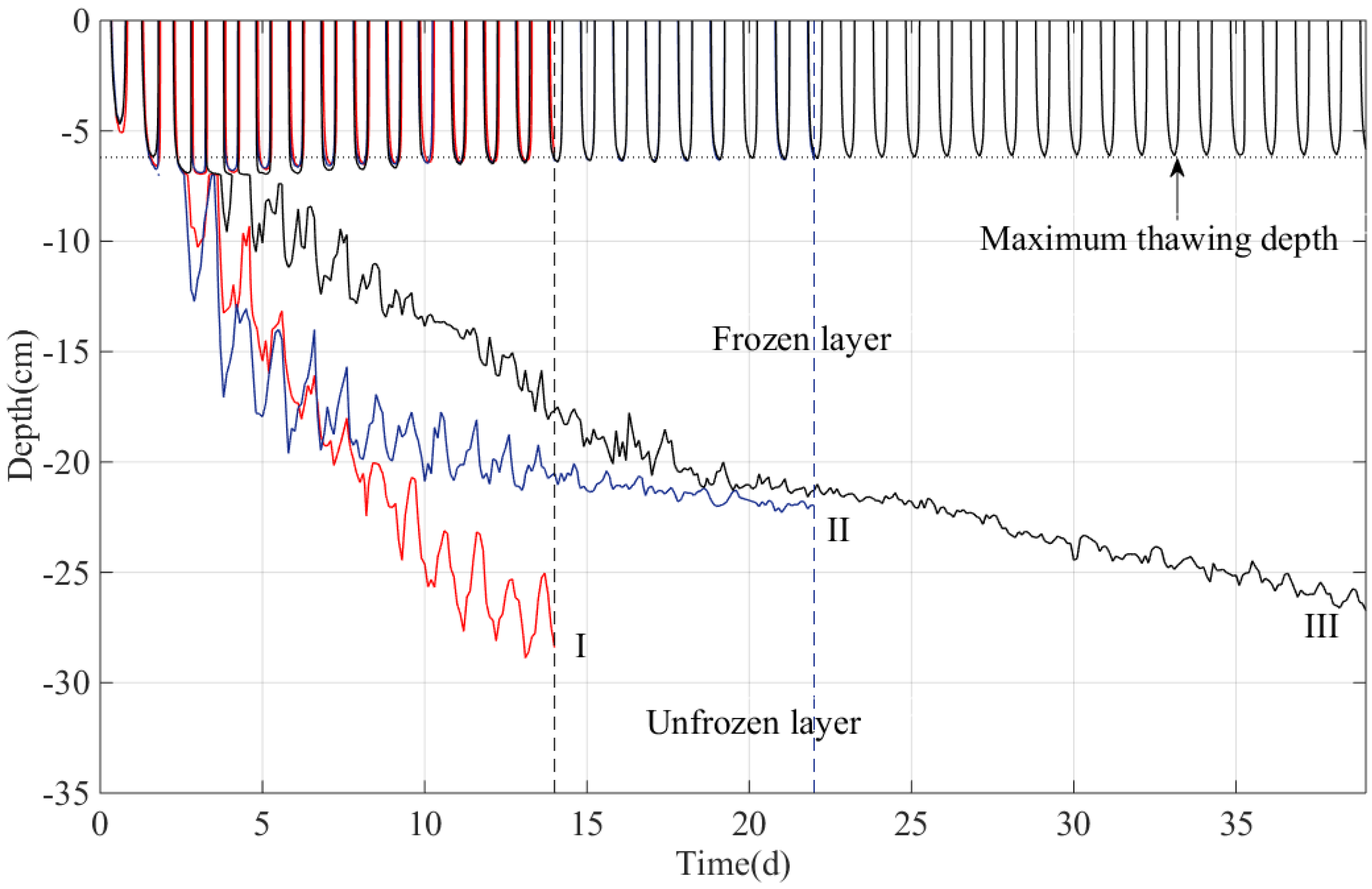

| Group | Times of Freeze–Thaw Cycle | Initial Water Content (%) | |
|---|---|---|---|
| I | 1.83 | 14 | 15 |
| II | 1.62 | 22 | 15 |
| III | 1.36 | 39 | 15 |
| Group/Location | B3 | C3 | D3 | E3 | F3 | Average Value |
|---|---|---|---|---|---|---|
| I | 5.59 | 4.38 | 2.98 | 2.35 | 2.10 | 3.48 |
| II | 6.26 | 6.26 | 6.39 | 6.36 | 5.97 | 6.25 |
| III | 4.10 | 3.97 | 3.95 | 3.98 | 3.89 | 3.98 |
| Group/Parameter | W/(m K) | W/(m K) | kJ/(m3 K) | kJ/(m3 K) |
|---|---|---|---|---|
| I | 1.60 | 1.82 | 2634.7 | 2032.5 |
| II | 1.28 | 1.45 | 2341.9 | 1806.6 |
| III | 0.92 | 1.24 | 2166.3 | 1639.3 |
Publisher’s Note: MDPI stays neutral with regard to jurisdictional claims in published maps and institutional affiliations. |
© 2022 by the authors. Licensee MDPI, Basel, Switzerland. This article is an open access article distributed under the terms and conditions of the Creative Commons Attribution (CC BY) license (https://creativecommons.org/licenses/by/4.0/).
Share and Cite
Zhang, J.; Zhou, C.; Zhang, Z.; Melnikov, A.; Jin, D.; Zhang, S. Physical Model Test and Heat Transfer Analysis on Backfilling Construction of Qinghai-Tibet Transmission Line Tower Foundation. Energies 2022, 15, 2329. https://doi.org/10.3390/en15072329
Zhang J, Zhou C, Zhang Z, Melnikov A, Jin D, Zhang S. Physical Model Test and Heat Transfer Analysis on Backfilling Construction of Qinghai-Tibet Transmission Line Tower Foundation. Energies. 2022; 15(7):2329. https://doi.org/10.3390/en15072329
Chicago/Turabian StyleZhang, Jun, Chenglin Zhou, Ze Zhang, Andrey Melnikov, Doudou Jin, and Shengrong Zhang. 2022. "Physical Model Test and Heat Transfer Analysis on Backfilling Construction of Qinghai-Tibet Transmission Line Tower Foundation" Energies 15, no. 7: 2329. https://doi.org/10.3390/en15072329
APA StyleZhang, J., Zhou, C., Zhang, Z., Melnikov, A., Jin, D., & Zhang, S. (2022). Physical Model Test and Heat Transfer Analysis on Backfilling Construction of Qinghai-Tibet Transmission Line Tower Foundation. Energies, 15(7), 2329. https://doi.org/10.3390/en15072329







